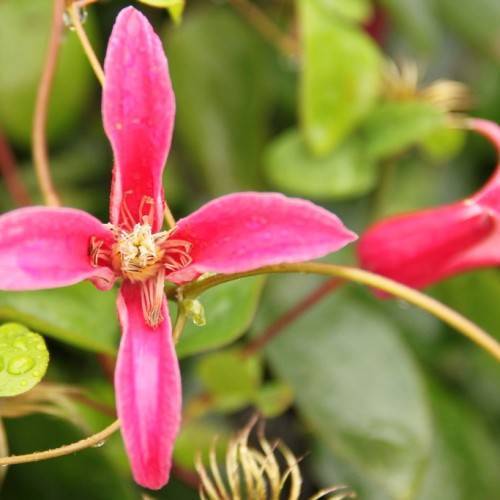
clematis
Clematis 'Princess Diana'
Cycle:
Perennial
Watering:
Average
Hardiness Zone:
4 - 8
Flowers:
Flowers
Sun:
Full sun,part shade
Leaf:
Yes
Growth Rate:
High
Maintenance:
Low
Care Level:
Medium
watering
The clematis (Clematis 'Princess Diana') should be watered once a week during the summer and once every 2 weeks during the winter. During hot, dry periods, water more frequently - approximately twice a week for both summer and winter. When watering, saturate the soil to a depth of 8-15cm (3-6 inches). Always avoid wetting the foliage when possible to reduce the risk of disease. Mulch around the base of the plant during spring and summer. This will help keep the soil moist and the roots cool. Also ensure the plant has good drainage, as they will not tolerate wet feet. If you have clay soil or the area is especially wet, consider mixing soil with compost when planting, to ensure better drainage.
sunlight
Clematis 'Princess Diana' is a fast growing climber and 1 of the most popular clematis vines. It prefers full sun, 5 to 6 hours of direct sunlight a day. This plant should be planted in a spot that receives at least 4 - 6 hours of sun daily, with optimal conditions in 8 hours of daily sun. Morning sun is best to avoid heat stress from the afternoon sun. If possible, plant against a south-facing fence or wall to maximize its sun exposure. It is important to note that the more sun it is exposed to, the more blooms it will produce, but be careful to not place it in a location that is too sunny, as this can cause the foliage to burn and become dry.
pruning
Clematis 'Princess Diana' is a popular flowering vine, and should be pruned regularly to keep it healthy and looking its best. Pruning should be carried out once a year, in the spring, when the new shoots begin to appear. Cut back any of the previous year’s growth to about 6 inches from the ground. You may also prune back old, damaged or dead stems. When pruning, avoid removing more than 1-third of the plant's shoots, since this can stress the plant. Also, be sure to make clean, sharp cuts with shears or a pruning saw. Do not prune Clematis 'Princess Diana' in the fall, as this may cause damage to the new shoots that have formed.
FAQ
Can Clematis plants grow in pots?
Yes, Clematis plants can definitely be grown in pots. When planting a Clematis in a pot make sure to use a larger size pot with drainage holes and fill it with a mix of well-draining potting soil and compost. Ensure to keep the root area cool and the pot in a sunny location while providing regular water and fertilization. Check the plant almost daily to make sure it is not becoming too dry. Clematis can do well in a pot and with the right care and conditions, they will thrive.
Are Clematis plants self-pollinating?
No, clematis plants are not self-pollinating. Clematis plants need pollinators such as bees, butterflies, moths and other insects to transfer pollen from the male anthers to the female stigma of the flower in order to produce viable seed. Pollination must also occur within relatively close proximity of the same species in order to create viable hybrid plants.
Can Clematis plants be grown as a houseplant?
Yes, Clematis plants can be grown as a houseplant. It is best to grow them in a pot with full sun and a soil that is rich in organic material and retains moisture. When potting the plant, place a stake or trellis next to the pot so that the vine can climb when it begins to grow. Be sure to water your Clematis plant regularly to keep it healthy and growing. Additionally, keep an eye out for pests and treat with natural insecticides as necessary.
Could Clematis plants survive in a colder climate?
Yes, Clematis plants can survive in colder climates with proper preparation. If planted in the fall, proper mulching should be done to protect the roots from cold temperatures. If planted in the spring, they should be watered frequently to help them adjust to the cooler temperatures more quickly. If temperatures drop below -20°C ( -4°F), additional measures may need to be taken such as the application of protective wraps and thermal insulation. Additionally, plants in exposed areas should be protected from the wind to prevent excessive dehydration. With the right measures in place, Clematis plants can easily survive in colder climates.
Could Clematis plants be grown in a greenhouse?
Yes, clematis plants can be grown in a greenhouse. Due to their vine-like growth habit and tropical native origins, clematis plants thrive in the moist and warm environment of a greenhouse. Clematis are generally grown from cuttings or from dividing existing plants, and benefit from regular pruning and fertilizing. They will also enjoy the indirect light of a greenhouse and the protection from strong winds and temperatures that the humidity and contained environment provides.
